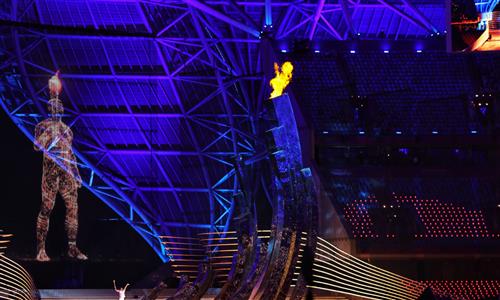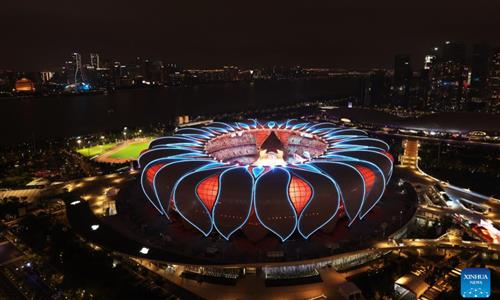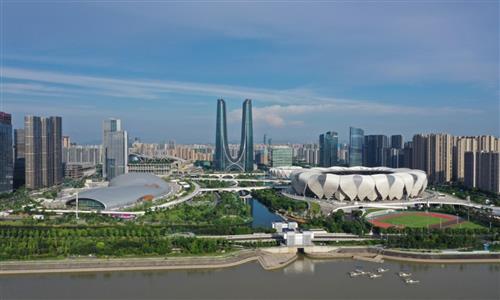ARTS / CULTURE & LEISURE
Hangzhou Asian Games opens, showing Chinese-style cultural beauty and romance through 'smart' interpretation
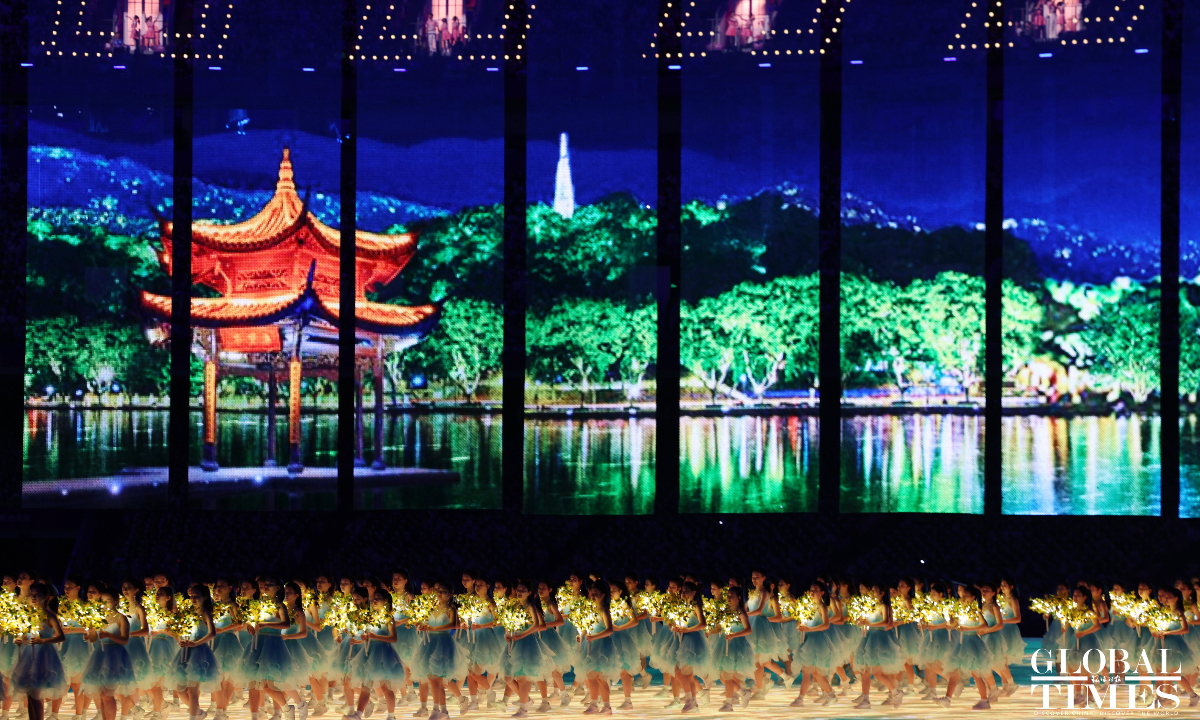
Photo: Cui Meng/GT
Be it the "AR sky lantern" or the "digital torch lighting" design, high technological implementations as exemplified by the Hangzhou Asian Games opening ceremony held on Saturday night have fulfilled China's promise to host an international sports gala that is sustainable and smart with China's cultural and romantic expressions.Along with futuristic designs, the Games' opening ceremony has interwoven with visual stories attributed to historical Chinese sites like the Liangzhu Site and also the country's cultural classics such as the Yueju Opera.
Cultural sociologist Chu Xin told the Global Times that those technological means were "samples" to show how modern China is able to give "innovative expressions of its historical culture."
"Such a futuristic yet classic opening ceremony can tell the world's audiences that China's modern social and cultural growth will always be in line with the country's historical profoundness," Chu noted.
"Tides Surging in Asia" was the theme of the Hangzhou Asian Games opening ceremony. Borrowing from the Chinese saying, "several streams flow into each other and surging into a tide," water in all its forms featured prominently at the opening ceremony, which saw the presentation of different performances that exhibited China's warm embrace of different Asian countries at the event.
The Surging Tides of Qiantang was a performance inspired by Hangzhou's most well-known natural tourist attraction, the Qiantang River. The river is known to have massive tides, along with a long-standing tradition of tide watching that was started during the Han (206BC-AD220) and Wei (220-265) dynasties.
During the performance, the Qiantang River's tide was projected as massive digital image at the venue's floor. Including showing audiences the Qiantang tides' most iconic scenes such as the "fish scale tide," the show also included two tide riders. With the support of an innovative 3D wire device, the two tide riders were able to hover above the ground. The two performers' interactions with the tide symbolized the bravery and courage that are part of the athletic spirit.
'Life force'
Xiong Gang, a Chinese folk culture expert, told the Global Times that tide riding was a competitive sport among ancient Chinese people. It also reflects the ancient Chinese philosophy to value the "harmony between humanity and nature."
The wave shape of the Qiantang River was also incorporated into the design of the announcement boards. Unlike many such boards that are square, those at the Hangzhou Asian Games were designed to look like a traditional Chinese fan complete with engraved peony flowers created through the use of Chinese fine brush painting techniques.
Yet, the whole fan was created through digital 3D printing.
Visual designer Xue Feifei told the Global Times that the design reveals the "life force" behind aesthetic traditional Chinese symbols used to inspire today's design creativities.
"Such unique designs are not only a pleasure to the eye, but convey designers' confidence in his or her cultural roots," Xue noted.
The Gongchen Bridge, as part of Hangzhou's historical architecture, was also digitally transposed on the stage, with the city's ancient and modern histories juxtaposed against each other on either end of the bridge. Following a "ship" that sails along the bridge on the Beijing-Hangzhou Canal, the world's longest and largest ancient canal, audiences followed the transformation of Hangzhou from "Lin'an," the capital of the Southern Song Dynasty (1127-1279) to being the present-day technological hub of China.
"The design showcases the cultural continuity of China as seen in Hangzhou," Chu told the Global Times.
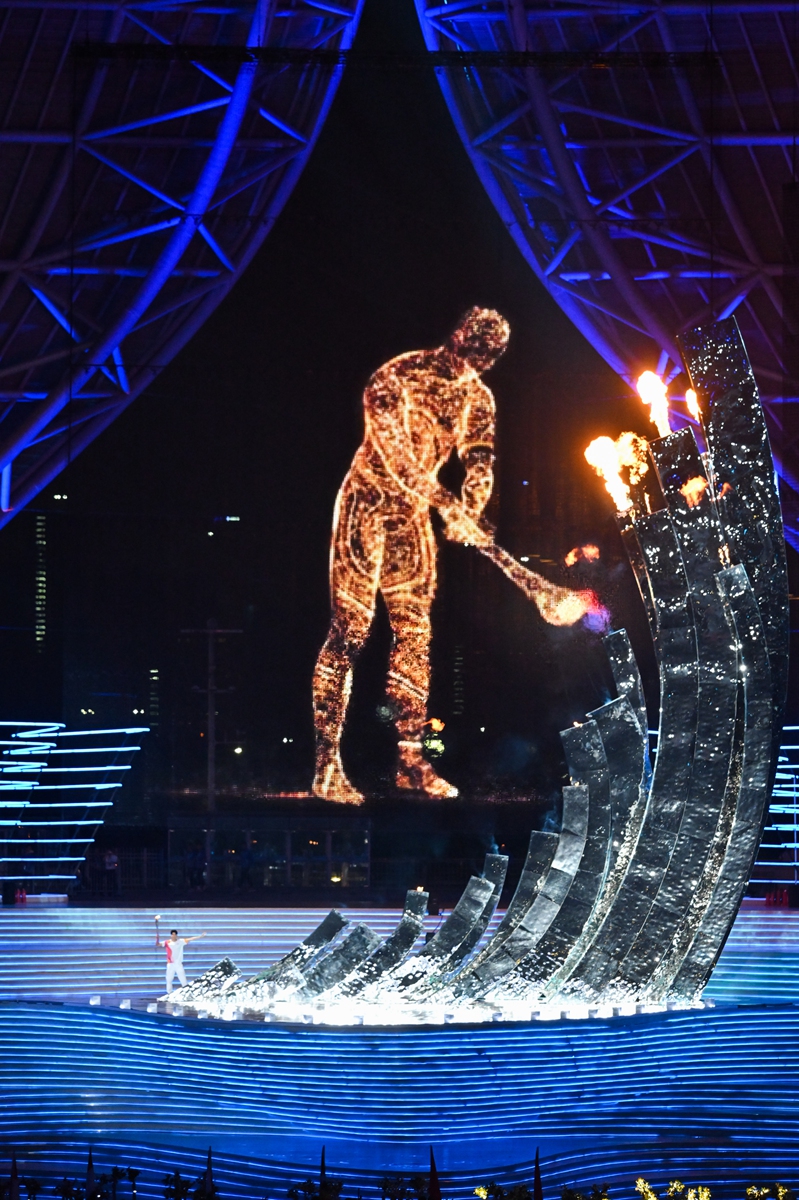
A digital torchbearer lights the cauldron during the opening ceremony of Hangzhou Asian Games on September 23, 2023. Photo: VCG
Stellar highlightHangzhou's more than 5,000-year-old Neolithic Liangzhu cultural history and legacy as a pearl in Chinese archaeology have been on full display as the city's most iconic artifact, the jade cong, was presented to audiences.
The jade cong was a type of ancient vessel symbolizing China's ritual system. Numerous jade cong-shaped instruments were incorporated into the stage, playing as drums to celebrate the arrival of international participants.
Ancient totem of the Liangzhu culture has also been transferred as the "badge of honor" shown at the digital torch bearer's body. The "digital torch man" design was the event's stellar highlight.
Other than historical elements, a suspended six-color screen was a highlight at the opening ceremony to showcase the glamor of Chinese poetry.
The six colors - vibrant red, laurus yellow, lake and mountain green, rainbow purple, glimmering blue, and mist white were used to embody different works of Chinese poetry like the Memories of Jiangnan created by Tang Dynasty poet Bai Juyi (772-846). His words, "At sunrise riverside flowers more red than fire; In spring green river waves grow as blue as sapphire," were experienced by audiences in vibrant rainbow purple.
In another example, the Lake-and-Mountain Green, the most abundant color in the opening ceremony's decorative elements, was cited in a poem penned by Gong Zizhen, a literary master in the Qing Dynasty (1644-1911).
"These hues are an interval and gradient, which on the one hand corresponds to the theme of 'light makeup and thick colors,'" said Guo Jinyong, the designer of the color scheme. "The refinement of these concepts gives the colors a more dynamic connotation."
As a tour de force of Chinese cultural aesthetics, the opening ceremony became a trending topic on the Twitter-like Sina Weibo, having been viewed by 140 million netizens.
There were also other cultural golden nuggets for discovery for eagle-eyed audiences, some of whom noticed the use of "Plum, Orchid, Bamboo, Chrysanthemum" patterns shown when athletes enter the event venue.
The four plants were dubbed the "Four nobles" in Chinese culture, and at the games were used to express China's appreciation and respect for participating world athletes.
"I hope the world will fully appreciate the unique and romantic way that we Chinese express our feelings," posted a netizen on Sina Weibo.
